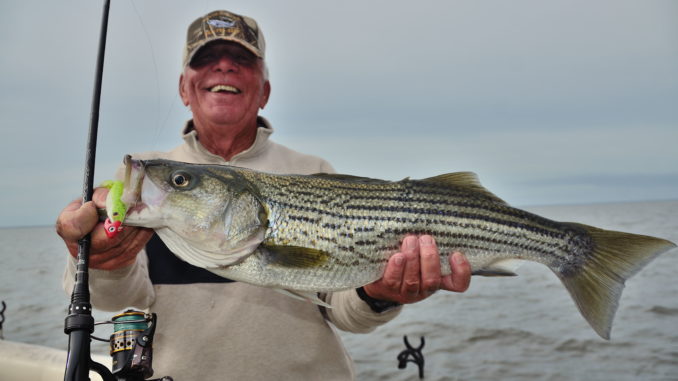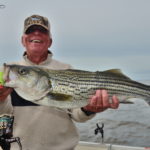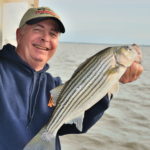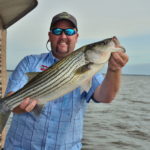
With the season open again, anglers visiting Lakes Moultrie and Marion need to be ready to take advantage of the year’s best striper schooling activity.
Anglers in the Carolinas are fortunate to be within driving distance of a true, freshwater paradise: the Santee Cooper lakes. With towering bald cypress and water tupelo lining the banks and massive beds of aquatic vegetation, the sheer beauty of Lake Moultrie and Lake Marion is evident. Sweeten the pot with a tremendous fishery for monster crappie, heavy stringers of largemouth bass, record-sized shellcrackers and colossal catfish and you’re really onto something.
But for adrenalin junkies looking for non-stop action, the fall season for striped bass can bring steady, heart-pounding action on a daily basis.
Almost 80 years after the lakes were impounded and the first population of landlocked striped bass in the United States was discovered, Santee Cooper has had a fishable population of stripers. Veteran guide Leroy Suggs believes the fishing is well above-average for the lakes’ history.
“Santee went through a bad cycle several years ago where the striper fishing was bad, but over the last few years, the fishery has bounced back strong and is fishing really good,” Suggs said. “As soon as the season opens, stripers are schooling hard and eating about everything they can.”
The S.C. Department of Natural Resources prohibits striper fishing on the Santee Cooper system between June 1 and Oct. 1 due to the high mortality rate of released fish during the summer. With a minimum size limit of 26 inches only a few keeper-sized fish get taken home, even on a triple-digit day, But it is not uncommon to catch dozens of blitzing stripers between 20 and 25 inches on fall days.
According to Suggs, stripers school in the deeper parts of the lakes near ledges and humps. They surround bait pods and run them around, gorging themselves. Since the fish are participating in full-fledged schooling behavior, locating big schools is the easiest part of the trip.
“Basically, you are looking for bird activity. The birds can see and hear the fish coming up better than we can,” Suggs said.
Typically, the birds identify the locations of the schools, but a good pair of binoculars sometimes comes in handy.
“The schools will be scattered all over the lakes, and being able to see them really helps a lot,” he said.
Stripers will not always stay up on top for very long. They are running bait to the surface, and once there, the bait quickly flees back down. Finding areas where schools are rising is all you need to start catching fish, according to Suggs.
“I look for bird activity, fish breaking the surface, and I then watch my graph closely. When you pass over a school or even near a school, the screen will light up, and you can catch fish for a long time after the school was on top,” he said.
Stripers are constantly chasing bait in the fall, and many anglers know it only by seeing breaking fish or hovering birds. For Suggs, however, the action is far heavier under the surface than what is visible on the surface.
“Fish run the bait under the surface, but you just cannot see it, he said. “And there are many more fish under the water that what you see breaking on the surface.”
Locating main schooling areas is the most-important part of a day’s trip, and since stripers are very mobile, a hot place one day doesn’t always equate to the next day’s hot spot. Anglers need to locate and identify surface-feeding action to keep participating in the action.
For guide David Hilton, weather conditions and time of day have an impact on surface activity.
“The best conditions are breezy, cloudy and cool days,” said Hilton. “The fish are more active on top and bite better when it’s rough and chilly, too. Stripers are going on a feeding frenzy just before winter arrives, and as it gets colder and colder, the fishing gets better until after the third heavy frost. By then, it is usually over.”
Fall stripers can be caught at Santee Cooper by trolling deep- diving crankbaits, casting lures or drifting live bait. Live bait is Hilton’s favorite way to get the action cranked up quickly.
“When they are biting good, you can throw the tackle box at them, and they will hit about everything,” he said. “But sometimes they don’t bite everything. When using live herring, like we do most of the time, they will eat it as soon as it gets down there.”
Hilton will drop his baits to a depth just above the stripers he marks on his depth finder or about halfway between the stripers and the surface. He uses a Carolina rig with a 5/8-ounce pinch sinker, 3 feet of 20-pound monofilament leader and a 1/0 to 2/0 light-wire hook. He likes the light-wire hook to allow the live herring to swim freely and lively.
“Stripers are very particular and will not eat sick-looking baits. Bait needs to be alive, and we try not to knock off scales to keep them looking good,” Hilton said.
Suggs will use live herring over schools, but he prefers to use artificial lures whenever possible: bucktails, swimbaits, Rat-L-Traps and spoons. A good, all-around choice is a soft-plastic bait threaded onto a heavy jighead, but he prefers spoons.
“Stripers love the spoons. Drop them to the bottom and power-reel them up as fast as you can. They will hit them like a reflex,” he said.
Another fun way to catch these fish when they’re actively busting the surface is to cast topwater bass plugs.
“Use topwater bass plugs, Striper Swipers, or anything that fishes at or near the surface that looks like a baitfish. Any time you see them up, you can use surface lures,” he said.
Suggs said stripers brought him to Santee Cooper more than 30 years ago, and the fall season is his favorite.
“Stripers really get my adrenaline going,” he said.
DESTINATION INFORMATION
HOW TO GET THERE — The Santee Cooper lakes, Marion and Moultrie, are between Columbia and Charleston, north of I-26; I-95 crosses Lake Marion. The two interstates provide good access to both lakes, along with US 52 and US 17. The lakes are literally ringed by public boat ramps; visit www.dnr.sc.gov for a complete list. The mid-lake areas of both lakes are the center of striper activity this month. Look for water between 20 and 45 feet deep near channel markers.
WHEN TO GO — Striper season on the Santee Cooper lakes opens Oct. 1 and ends June 1. October and November are the two best months to catch stripers on both Lake Marion and Lake Moultrie.
BEST TECHNIQUES — Anglers can locate stripers on their depth finders or by watching for fish crashing baitfish at the surface. When fishing the topwater jumps, Rat-L-Traps, Vudu Mullet, Mambo Mullet and a variety of crankbaits and topwater plugs will generate strikes. For fish down in the water column, jig 1- and 11/2-ounce Hopkins or Flex spoons, or bucktails with plastic trailers. For anglers who prefer live bait, a live blueback herring suspended above stripers on a Carolina rig is almost a guarantee for action. Use 18 to 24 inches of 20-pound mono for a leader below a 1- to 2-ounce egg sinker. A 1/0 to 3/0 light-wire hook should be sufficient.
FISHING INFO/GUIDES — Leroy Suggs, Leroy’s Striper Charters, 910-995-1168; David Hilton, Santee Cooper Fishing Guide Service, 843-870-4734, www.davidhilton.com. See also Guides and Charters in Classifieds.
ACCOMMODATIONS — Blacks Camp, 843-753-2231, www.blackscamp.com; Santee Cooper Country, 803-854-2131, www.santeecoopercountry.org; South Carolina Association of Visitors Bureau, www.discoversouthcarolina.com.
MAPS — Navionics, www.navionics.com; DeLorme S.C. Atlas & Gazetteer, 207-846-7000, www.delorme.com; Kingfisher Maps, 800-326-0257, www.kfmaps.com.





Be the first to comment